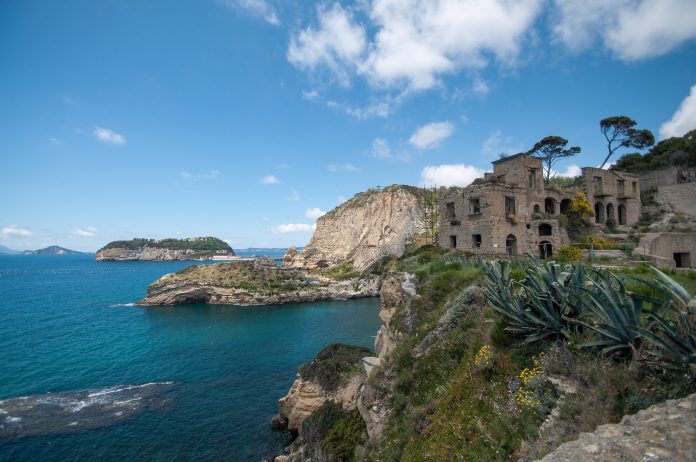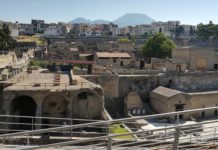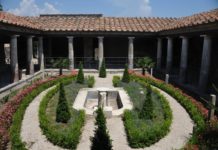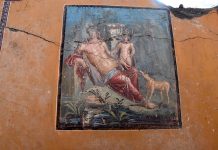An open door in the space of time continuum which takes you back at least two thousand years. Arthur Conan Doyle, the inventor of Sherlock Holmes, would have been over joyed to discover, that the idea behind his book “The Lost World”, is reality in Naples. The cave of Seiano, which crosses the promontory of the hill of Posillipo from Coroglio to the Gaiola, is actually a long gallery (of about 770 meters), artfully dug out in the yellow tuff of the hill at the beginning of the first century AD, using techniques still partially unknown. It was probably built on the project of a freed slave, a talented architect and engineer, Cumano Lucio Cocceio Aucto, who also created the most famous Crypta Neapolitana.
After the fall of the empire, the tunnel was no longer used and was forgotten. Its function of linking the numerous villas of the Roman patricians of Posillipo hill with the city of Puteoli, which had been the commercial port of Rome, ceased for a long streach of time. Almost a thousand years later, in 1456, Alfonso I of Aragon ordered its recovery, because he considered considerably useful, its direct connection of the city of Naples with Bagnoli. The works were carried out in a rather approximate manner, to the point that new collapses, made the cave impractical almost immediately, until it fell into oblivion once more. It was rediscovered relatively recently, in 1840, during the construction of the new road of Posillipo. Ferdinand II of Bourbon, fascinated by the find, wanted to enter it personally, against the opinion of his court of companions and of the technicians who were working on the site. Immediately after his visit, he ordered its restructuring and reopening. Since then, the cave of Seiano has not been forgotten by the Neapolitans, even if it has been closed and reopened countless times. Obviously, similar to the hundreds of Neapolitan tuff caves, it was transformed into a shelter for the local population during the aerial bombardments of the Second World War. From the sixties to the mid-eighties, it was also used as a storage warehouse by cigarette smugglers who, aboard their powerful blue motorboats, animated the Gulf with daring escapes from the equally powerful vedettes of the Guardia di Finanza.
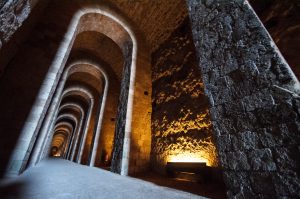
The cave of Seiano is not far from the wonderful bay of Bagnoli, whose panorama is devastated by the remains of the most modern iron and steel factory of the Seventies in Italy. It was closed because it became unproductive and useless for the “steel quotas” established by the European Community. To cross the cave, one has to walk through seven hundred meters, in semi-darkness, torn only by the light of three openings which overlook the tufaceous cliff of Trentaremi, with its sparkling sea below. Suddenly, after darkness, the light. One can finally access the Archaeological Park of Pausilypon and the Submerged Park of Gaiola, which is one of the best preserved Roman imperial villas in Italy.
At the present time the Park is managed by the Superintendency of Archeology, Fine Arts and Landscape of Naples. The management and development of the structure are entrusted to the Interdisciplinary Study Center Gaiola onlus, made up of naturalists and archaeologists. Thanks to these young scholars, who have concretely contributed to its recovery, the entire area is open to the public.Born as the residence of a rich Roman knight of the 1st century BC, Publius Vedio Pollione, at the death of the knight, bought the villa. The Roman patrician did not randomly choose the name for his villa: in ancient Greek, Pausilypon stands for “relief from troubles”. To understand the reason for this choice, one should read the description of its panorama, written by the London scholar Robert William Theodore Gunther, a historian of science, and author of a precious book on the residence of Pollione and on the hill of Posillipo: “… beyond all, a wide panorama on the blue sea: all placed in a row, in an incomparable expanse, one can admire the Vesuvius and the highlands of Sorrento and the islands of Capri, Nisida, Miseno and Ischia. Sometimes, when the sky is clear, the rocky island of Ponza can be outlined against the sunset ”.
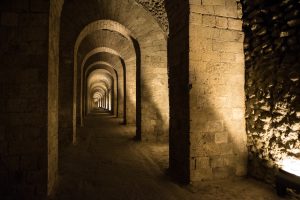
Vedio Pollione, was appointed governor of Asia, after the battle of Actium. He spared no expenses to build his “Neapolitan Paradise”. The villa occupied a very large area, not exactly determinable nowadays due to the various alterations suffered over time, which Pollione starting enlarging immediately after its acquisition. However, it went from the exit of the cave of Seiano to the sea, across a series of terraces, where its stupendous fish ponds were placed. Now they lie three meters underwater, after the bradyseismic phenomena which are a common feature in the Neapolitan and Phlegraean coast.
It had the structure of a rich classic Roman maritime villa, which had been adapted to the territory, making full use of the space and the potential of its various landscape views. It was therefore made up of several structures, each with its own function which have not all been identified yet. In the highest part of the complex, there was a public area with two structures dedicated to leisure: an odeion, intended for poetry and monologue reading, and a two-thousand-seat theater, modeled on Greek theaters. It is important to remember that Naples, at that time, was a Greek city in all its aspects: in its language, in its customs, in its social organization and in its religion. Thanks to its characteristics, together with the beauty of its places, it fascinated and attracted the Roman patricians.
At the moment, during the summer period, in the theater of the villa, which has been almost completely restored, the Interdisciplinary Study Center Gaiola onlus, organizes theatrical shows with the most excellent of theatre companies. One cannot fail to note that in these summer evenings the coolness of the sea breeze and the wonderful background of the Gulf make the audience live a truly unique experience. On the east side of the theater, are the remains of a building that Gunther had identified as a Temple, but it is not known if his interpretation is correct. Observing other Roman imperial villas, it could be the entrance building to the theatre area. On the west of the theater, there is another construction that has always been identified as a nymphaeum. Actually, according to archaeologists, it could be a small stadium, if we bear in mind the habit of frequently organizing athletic competitions in Greek Naples. From there, right down to the sea, one can see the ruins of other small buildings in a forest of wonderful large oak trees.
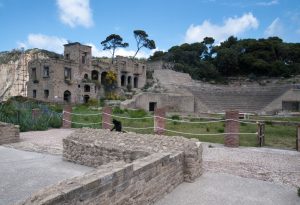
In the lower part of the villa of Pollione there is the second part of the Archaeological Park: the Submerged Park of Gaiola and its marine protected area. In the depths of the Gaiola, just a few meters below the water, a large amount of ruins testify how majestic this imperial complex was. Boats equipped with transparent bottoms, are usually used in the guided sea tours. If desired, one can take part in snorkeling meetings, in order to admire the enormous fish and sea mollusks hatcheries. Also visible are the docks for mooring boats, and all the buildings that embellished the villa, such as the arcades, the nymphaeums and the large loggias.
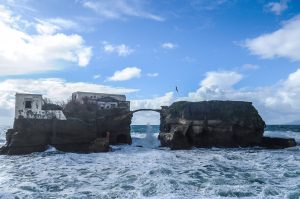
There, in 2002, the Marine Protected Area was established on an area of 41.6 hectares. In 17 years, thanks to the morphology of the seabed and the favorable circulation of the sea currents, biodiversity has been rapidly recreated. In the upper part of the villa, on the reef of Trentaremi, the peregrine falcon, the buzzard and the royal gull nest, while in the waters of the Gaiola live undisturbed and thriving fish such as the morays, groupers, octopuses and a large number of other species of fish which had no longer been seen in the Gulf for decades. Nowadays, thanks to the enthusiasm and determination of the scientists of the Gaiola non-profit Interdisciplinary Study Center, the Submerged Park has become an important site for research, training, scientific dissemination and environmental education for the rediscovery and enhancement of the naturalistic and cultural heritage of Naples. It is a magical place where history merges with unspoilt and unspoiled nature. A place that nobody could imagine possible in a chaotic, overcrowded and distracted city like Naples. It is a must see.
A project for the Mediterranean
They called it Progetto StaMM with the precise intent to obtain a double meaning. The acronym means Marine Monitoring Environmental Station, but “stamm”, in the Neapolitan language means we are, that is, here we stay to develop the South and we will not emigrate to other Countries, as a large part of the southern youths do. The Project is co-financed by the Fondazione Con il Sud, as part of the Bando Ambiente 2015 and provides for the functional recovery of a wing of the historic Villa della Gaiola (in the last hundred years it has belonged to more or less famous people), aimed at the realization of a Permanent environmental monitoring station on the Marine Protected Area of Gaiola. But this is only the first step, because the Gaiola Onlus Interdisciplinary Study Center aims to start a shared virtuous process of environmental protection, through the participatory recovery of the Villa della Gaiola, for the creation of the International Center for the study and preservation of the archaeological and naturalistic heritage of the Mediterranean Sea.
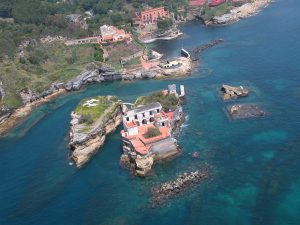
ARCHAEOLOGICAL PARK OF PAUSILYPONGrotta di Seiano – Discesa Coroglio 36, 80124 – Napoli Guided tours: – Tuesday to Friday 12.00 – Saturday and Sunday 10.00 and 12.00. For groups and school groups, guided tours are possible even on different days and times.
Reservations required: Tel / Fax: 0812403235 – 3285947790 – info@gaiola.org – www.gaiola.org
SUBMERGED PARK OF GAIOLA
CeRD A.M.P. Parco Sommerso di Gaiola – Discesa Gaiola (scogliera), 80123 – Napoli
Visitor and Cliff Center Zone A: Winter: from 1st to 31st October: every day except Monday 10.00 am – 2.00 pm – from 1st November to 31st March: Tuesday, Thursday and Saturday 10.00 am – 2.00 pm.
Summer: from April 1st to September 30th: every day except Monday 10.00 am – 4.00 pm The entrance to the Reef of Zone A is regulated (https://www.areamarinaprotettagaiola.it/disciplinari)
Guided tours (only from April to October): – AquaVision boat (with a transparent bottom): 10.30, 12.30 and 15.00 – snorkeling: 11.00 am and 14.00 – diving: 9.00 – integrated land-sea (Pausilypon + Gaiola): 9.00 am (departure from the Grotta di Seiano).
Visits usually take place on weekends. For groups and school groups, guided tours are possible even on different days and times.
Reservations required: Tel / Fax: 0812403235 – info@gaiola.org – www.gaiola.org

 Italiano
Italiano

